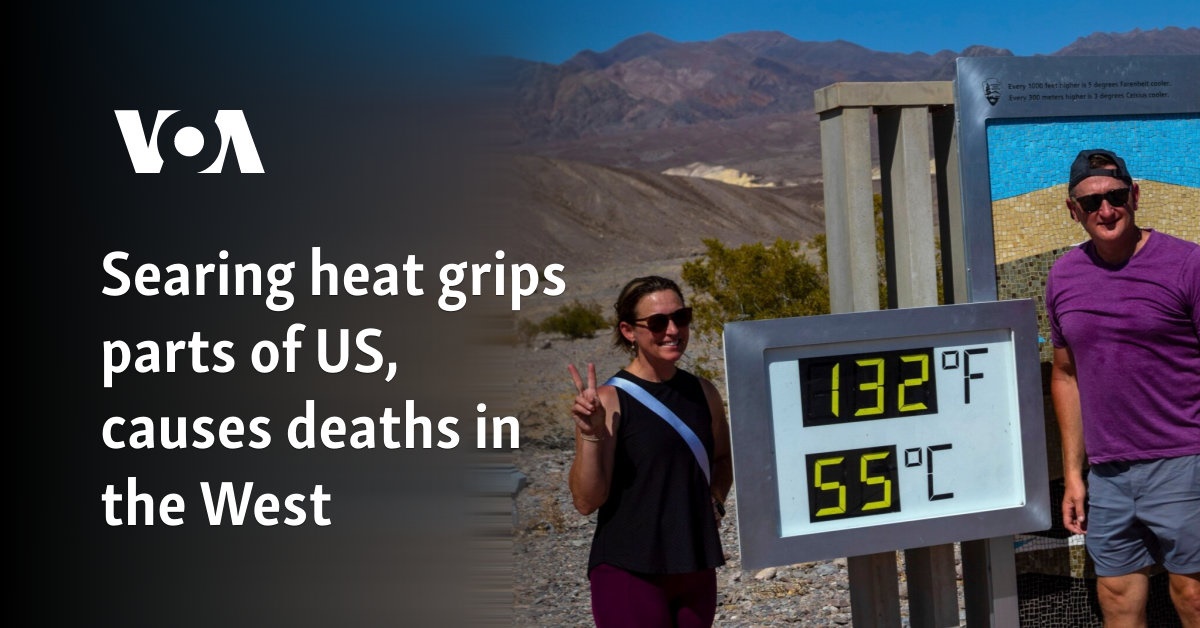Scorching heat hits parts of the USA and claims lives in the West

A scorching heat wave hit much of the United States on Monday. Record-breaking daily temperatures in Oregon are believed to be responsible for four deaths in the Portland area after a motorcyclist died in dangerous heat in California’s Death Valley over the weekend.
More than 146 million people in the U.S. were under heat warnings on Monday, mostly in the western states. California, Nevada, Arizona, Oregon, Washington and Idaho were under extreme heat warnings on Monday, the highest warning level issued by the National Weather Service, while parts of the East Coast as well as Alabama and Mississippi were under heat advisories.
The early heat wave in the U.S. came as global temperatures hit a record high for the 13th consecutive month in June and the 12th month in a row that the Earth was 1.5 degrees Celsius (2.7 degrees Fahrenheit) warmer than pre-industrial times, Europe’s Copernicus climate service said.
Many locations across the West and Pacific Northwest set or broke previous heat records over the weekend, and those records are expected to continue into the coming week.
In Oregon’s Multnomah County, home to Portland, the medical examiner’s office is investigating four suspected heat-related deaths recorded Friday, Saturday and Sunday, officials said. Three of the deaths involved county residents ages 64, 75 and 84, county officials said in an email. Heat was also suspected in the death of a 33-year-old man who was admitted to a Portland hospital from outside the county.
Portland set record daily temperatures on Friday, Saturday and Sunday and will do so again on Monday with a forecast high of 102 degrees Fahrenheit (38.9 degrees Celsius), National Weather Service meteorologist Hannah Chandler-Cooley said. High temperatures are expected in Portland through Tuesday evening.
“We are exploring the potential to break further records,” she said.
Temperatures are not expected to be as high as a similar heat wave in the Pacific Northwest in 2021, which killed an estimated 600 people in Oregon, Washington and western Canada. But the duration could be problematic because many homes in the region do not have air conditioning. Round-the-clock hot weather prevents people from cooling down adequately at night, and the problem is exacerbated in urban areas where concrete and pavement trap heat.
Heat illnesses and injuries are cumulative and can develop over the course of a day or several days, officials warn. In San Jose, California, a homeless man died last week from apparent heat-related causes, Mayor Matt Mahan reported on the social platform X, calling it “a preventable tragedy.” San Jose police said the man’s body showed no obvious signs of foul play.
In the scorching desert of Eastern California, high temperatures of 53.3 degrees Celsius were recorded in Death Valley National Park on Saturday and Sunday. One visitor, whose identity is unknown, died of the heat on Saturday. Another person was hospitalized, authorities said.
They were among six motorcyclists who rode through the Badwater Basin area in sweltering heat, the park said in a statement. The other four were treated at the scene. Rescue helicopters were unable to respond because the aircraft generally cannot fly safely in temperatures above 120 degrees Fahrenheit (48.8 degrees Celsius), officials said.
Even more extreme high temperatures are forecast in the short term: highs of around 52.7 °C (127 °F) are expected in Death Valley on Monday, with a possible high of 54.4 °C (130 °F) by mid-week.
Death Valley, the largest national park outside Alaska, is considered one of the most extreme environments in the world and is one of the hottest in summer. The highest temperature ever officially recorded on Earth was 56.67 °C (134 °F) in July 1913 in Death Valley, although some experts dispute this measurement and say the true record is 54.4 °C (130 °F) measured there in July 2021.
“While it is very exciting to experience potentially world-record temperatures in Death Valley, we advise visitors to choose their activities carefully and avoid spending extended periods of time outside of an air-conditioned vehicle or building in such high temperatures,” said park ranger Mike Reynolds.
Across the desert in Nevada, Las Vegas recorded a record high of 120 °F (48.8 °C) on Sunday, and a record high of 115 °F (46.1 °C) was forecast for Monday. The National Weather Service forecast a high of 117 °F (47.2 °C) in Phoenix.
On Monday, people flocked to the beaches around Lake Tahoe, especially Sand Harbor State Park, where Sunday’s crowd count of 92 (33.3) beat the previous record of 88 (31.1) set in 2014. For the fifth day in a row, Sand Harbor closed its gates within 90 minutes of opening at 8 a.m. because capacity had been reached.
“It’s definitely hotter than we’re used to,” said Tyler Kerver, spokesman for Nevada State Parks.



